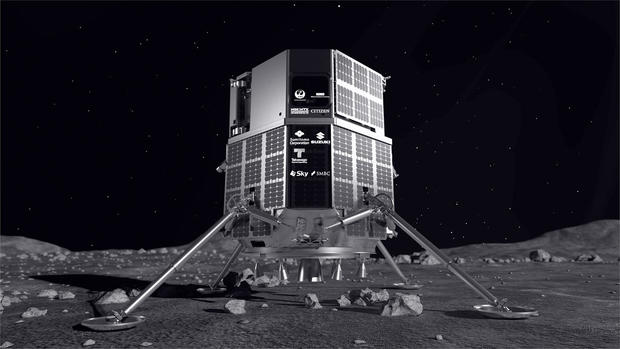SpaceX launches Japanese robotic lander and NASA ice mapper to the moon
A SpaceX Falcon 9 rocket blasted off early Sunday from Cape Canaveral, boosting a commercially developed Japanese moon lander into space for a three-month voyage to touchdown in a 54-mile-wide crater. Also on board: A small NASA orbiter that will search for ice deposits in cold, permanently shadowed craters near the moon's poles.
Appropriately enough, the launching came on the 50th anniversary of the last Apollo moon landing in 1972 and just 10 hours before NASA's unpiloted Orion moonship was expected to splash down in the Pacific Ocean west of Baja California to close out a 25-day test flight.
Orion's Artemis 1 mission is intended to pave the way for piloted flights to the moon starting in 2024. Tokyo-based ispace, builder of the Hakuto-R lunar lander, hopes to help pave the way toward commercial operations on the moon, carrying small government and civilian payloads to the lunar surface.
The mission got underway at 2:38 a.m. EST when the Falcon 9's first stage engines ignited with a ground-shaking roar and throttled up to 1.7 million pounds of thrust to begin a sky-lighting climb to space.
The first stage, making its fifth flight, propelled the 229-foot-tall rocket out of the lower atmosphere, then separated, flipped around and headed back to landing at the Cape Canaveral Space Force Station.
Heralded by window-rattling sonic booms, the slender booster descended on a brilliant jet of flame, deploying four landing legs a moment before settling to a picture-perfect landing on a concrete pad. It was SpaceX's 155th successful booster recovery, its 27th in Florida and its second in three days.
Hakuto-R, meanwhile, was released from the Falcon 9's second stage about 47 minutes after launch. It is expected to reach the moon in five months, using a low-energy trajectory that will carry it a million miles into space. The gravity of the sun and Earth, along with periodic firings of on-board thrusters, then will combine to pull the craft back to the moon.
If all goes well, the spacecraft will descend to the floor of Atlas Crater with a rocket-powered landing in late April, touching down on four shock-absorbing legs.
Once on the surface, a small 22-pound rover known as Rashid, built by United Arab Emirates, will roll down a ramp and onto the surface to study the geology of the region, soil properties, dust movement and the electrically charged plasma environment.
An even smaller half-pound rover the size of a baseball, known as the Japanese Lunar Excursion Vehicle, will carry its own cameras onto the surface for independent research.
Takeshi Hakamada, founder and CEO of ispace, said the company's goal is to help foster development of a lunar economy and infrastructure by providing rapid access to the surface of the moon, augmenting the NASA-led Artemis program.
"It's an honor to become the first launch and the first (privately funded) landing on the lunar surface," Hakamada said in an interview with CBS News. "However, this is not our goal. Our goal is to create a sustainable ecosystem.
"We need to have at least several competitors in this market. Otherwise, there's no incentive to grow this industry. So I'm very happy to have other competitors ... and growing this industry together with them."
Joining Hakuto-R aboard the Falcon 9 was NASA's Lunar Flashlight, a so-called "smallsat" equipped with four infrared lasers. Orbiting the moon in a hugely elliptical orbit carrying it as far as 43,000 miles from to surface to within just nine miles at closest approach, the Lunar Flashlight will probe the lunar soil below for signs of ice.
Rock and soil will simply reflect and scatter the laser light, but ice will absorb it. NASA is especially interested in probing permanently shadowed craters near the moon's south pole where earlier satellite observations detected chemical signatures that could indicate the presence of ice.
Ice could be a critical resource for future astronauts and it's a central theme in NASA's Artemis program. If accessible deposits are found, the ice could be broken down into oxygen and hydrogen, allowing future explorers to manufacture rocket fuel, air and water on the moon, without the huge expense of hauling the commodities up from Earth.
"We are bringing a literal flashlight to the moon, shining lasers into these dark craters to look for definitive signs of water ice covering the upper layer of lunar regolith," Barbara Cohen, the principal investigator, said in a NASA release. "I'm excited to see our mission contribute to our scientific understanding of where water ice is on the moon and how it got to be there."
Hakuto-R is a technology demonstrator and is not equipped with any instruments of its own. But Hakamada said ice is a critical enabler for the eventual development of a commercial infrastructure on and around the moon.
"We believe that's going to be the key to initiate the lunar economy," he said. "In order to utilize such resources, we believe that in the near term we need high-frequency transportation to the lunar surface to support scientific missions, exploration missions, and also technology demonstration missions.
"We are planning to offer frequent missions to the surface. After 2025, we plan to offer two to three missions per year."







